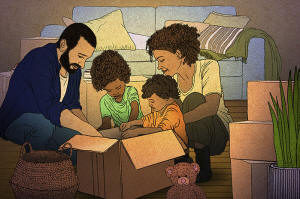Moving to a new home or school can stress kids out. How to make it more
manageable
[August 20, 2025]
By KATHERINE ROTH
NEW YORK (AP) — Summer can be a time of big transitions for kids. It's
often the season for moving to a new home or preparing for a different
school. And that brings worry and stress.
Parents and families can help make things feel more manageable. If kids
feel supported, they might even look forward to some of the changes and
gain confidence, experts say.
“When routines, familiar places and even knowing where things are in the
house are suddenly gone, it forces youth to relearn their daily lives
from scratch,” which can be stressful, says Victoria Kress, a
professional counselor and president of the American Counseling
Association.
At the same time, “this can invite exciting opportunities for growth,"
she says.
Author Nadine Haruni’s book “Freeda the Frog is on the Move” aims to
help school-age kids deal with moving. Haruni, who guided her own family
through moves and changes, tells the story of a mother frog who helps
her little tadpoles adjust as they leave their hometown and settle in a
new one.
“It’s really important to recognize that transitions take time and that
is totally normal. It’s OK to feel nervous and sad and anxious and maybe
all of those things all at once, and even adults feel that way
sometimes,” says Haruni.
“If you listen, you might be surprised. What matters to a child is not
always what you might think it is,” she says.

Moves can be especially difficult if accompanied by other significant
changes, such as a death, divorce or loss of family income.
Haruni’s book was inspired by her family’s big, multifaceted transition.
She was moving from Manhattan to New Jersey with her then-5-year-old
daughter and 8-year-old son, and getting married all in the same week, a
big transition for her kids and three teenage stepdaughters. In
addition, the kids were starting at a new school the following week.
“The kids were very sad and worried at first. Life is about change, and
it’s really hard to address that sometimes. Luckily, the kids discovered
that they loved having more space and, like the tadpoles in the book,
they happily adapted,” she says.
Here are some tips to reduce the stress of a move or other big
transition for kids:
Talk it out
“Communicating and listening can alleviate a lot of anxiety,” Haruni
says. “Let kids share their feelings and know that they are being heard,
so they know that they matter. That really helps them feel like they
have some control.”
Explain why a move is necessary, and preview what’s ahead. Discuss the
destination ahead of time, especially its good points. Familiarity can
help kids feel more confident, the experts say.
[to top of second column]
|

(AP Illustration / Peter Hamlin)
 Even sharing some photos or a map is
helpful in easing jitters.
“Can they meet a few kids in the new neighborhood ahead of time?"
Haruni asks.
Involve kids in the move itself
“Involving children in age-appropriate moving tasks — such as
packing their own belongings or helping to choose new room
decorations — can give them a sense of control and security during
an uncertain time," says Kress.
Kids can help plan meals, organize their space or continue family
traditions.
“Frame it as an adventure," says Haruni. "Let them help choose
things for their new room if they are moving, but also bring a few
items that feel familiar and comforting."
Keep up daily routines
Sticking to some daily routines creates structure when things feel
new and scary.
“The thing with moves is they disrupt everyone’s life. Too much
change at once discombobulates everybody, so keeping meals at the
same time and bedtime rituals the same can really help a lot,” says
George M. Kapalka, a clinical psychologist and professor at the
California School of Professional Psychology, part of Alliant
International University.
Arrange common areas similarly to how they were before the move,
says Kress. Place favorite toys, blankets or pictures where your
child expects to find them.
Consider getting help from a professional
Adapting to change takes time, and patience. Let kids know that's
normal, that they will get through it, and that they are being heard
and have some control over things, says Haruni.
And know when to seek help.
“Some sadness, worry, or adjustment difficulties are normal after a
move. But if symptoms persist for more than a few weeks, worsen over
time, or disrupt daily life, then counseling is advisable,” says
Kress.
All contents © copyright 2025 Associated Press. All rights reserved
 |